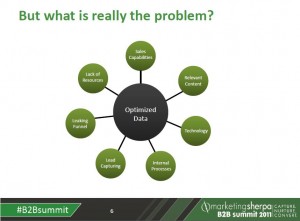Fellow marketing managers, commiserate with me for a moment. I’m sure you’ve been in a similar situation. You’re given a new marketing initiative that you know little to nothing about. For some it might be Twitter. For others, maybe landing page optimization. My intimidating hill to climb, was the webinar.
While preparing for today’s MarketingSherpa webinar about email relevance and deliverability, and researching for the past couple of months on webinar creative practices, it became more evident to me that a clear marketing strategy was needed in order to produce better webinars in the future.
Highlighted below are the six tactics that I found successful for creating a clear webinar strategy and currently impact the way I plan, create, and promote MarketingSherpa webinars. And if you’re a MarketingSherpa member, we even have a complimentary Sample Webinar Plan that you can download.
Step #1: Know your deadlines and deliverables
Early communication with the sponsors, clients, and presenters is key. Email them and introduce yourself laying out a timetable for future meetings and deadlines. Once you know the key dates and information (webinar date, presenters, and topic), work backwards from the date of the webinar and set up target dates for completion. Important dates to remember include:
- Landing page setup and review
- Launch calls
- Presentation deadlines
- Dry runthrough
I highly recommend you set up a launch call to review these deadlines and discuss any concerns as well as present an overall webinar outline for a suggested topic.
Step #2: Map out an effective marketing plan
Once you have confirmed the target dates and deliverables, you can begin to create a marketing plan. This plan should include your plans on promoting the event (emails, banner ads, social marketing) along with key dates and deadlines. The difference between a good plan and much better plan is in the details. The more specific you can be with target audience, goals, and call to action, the more effective your plan will be. When this is completed, send it to all the parties involved (including your sponsors and presenters if applicable) so they can see the plan details and discuss plan specifics.
Step #3: Create relevant webinar copy for target audience
Relevancy is the key. If your audience feels that the webinar subject and email copy is relevant to their needs then you will be more successful in engaging prospects. As Flint McGlaughlin, Managing Director (CEO), MECLABS always says, “Clarity always trumps persuasion.”
Shy away from vague statements like “leading,” “best” and “most.” Be specific. For example, “Homepage Design: The five most common pitfalls and how to overcome them” Subject titles and copy that are specific may be enticing to a smaller audience, but most of the time this audience is highly interested and therefore a better lead. Always include a good call to action and use this line of thinking when creating copy, “If I am the ideal prospect, why should I attend your webinar?”
Step #4: Apply marketing promotions across all channels
Using a number of highly targeted email blasts from in-house and sponsors lists, along with banner ads, you can bring in a significant amount of attendees. However, when marketing for our last webinar 2011 Top B2B Marketing Practices: From Lead Generation to Marketing Automation, it was the social media activity (Twitter, LinkedIn, and blogs) that drove an additional 200-250 attendees within a week of the webinar. When tweeting, make sure to begin to establish the Twitter hashtag you plan to use to live tweet during the webinar.
Many companies do a number of webinars a month and using every avenue possible to create buzz is crucial to a webinar’s success. I’ve found that the sweet spot for marketing is two weeks to the day before the event.
Step #5: Preparation precedes power – practice and execution of the webinar
No matter what webinar platform you use (GoToWebinar, WebEX, ON24) it is imperative to learn the basics of these programs before you begin using them. Spend some time watching the “best practices” training presentations, and reading the FAQs and how-to sections many of these platforms offer.
Knowing the tips and tricks of how each of these platforms function will be critical to avoiding “Uh oh” moments. Familiarize yourself with the important functions, like polls, registration questions, follow-up emails, and reminders.
Also, familiarize yourself with Twitter. Establishing a Twitter hashtag, and having at least one person from your company live tweeting during the webinar, is a great way to drive conversation and interaction and also gauge the sentiment of your audience in real-time.
Bottom Line: Your preparation will give you the power you need to execute the webinar and the practice will give you the peace of mind.
Tactic #6: Follow up and review – continuing the conversation
Once the webinar has concluded, it’s important to keep the conversation going. Sending a follow-up email containing the slide presentation and any special offer material you promised is only one part of the conversation. The second important part is keeping them engaged with other webinars, articles, books, classes, and events that apply to the topic of the webinar. Think of Amazon, “Those who attended a webinar like you also found this interesting…”
It’s also important to review how the webinar went. Spend an additional five to ten minutes getting feedback from the speakers and monitoring the Twitter hashtag after the webinar concludes. This feedback will help you in making improvements in future webinars.
Related resources
Marketing Webinar Optimization: Five questions to ask yourself about webinars
B2B Marketing: Take established tradeshow best practices and adapt them for an online audience with virtual events
Members Exclusive: Download your complimentary Sample Webinar Plan









